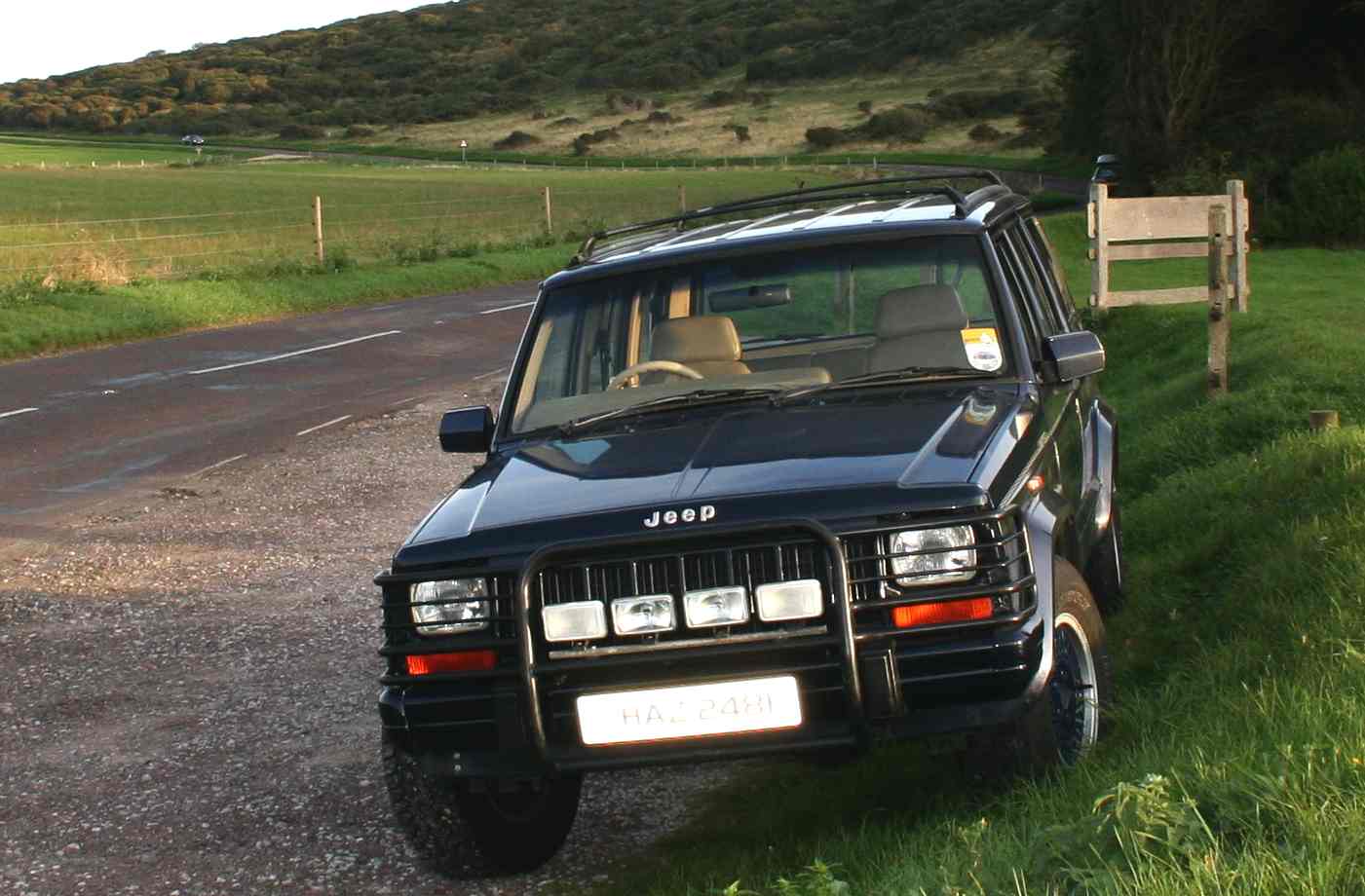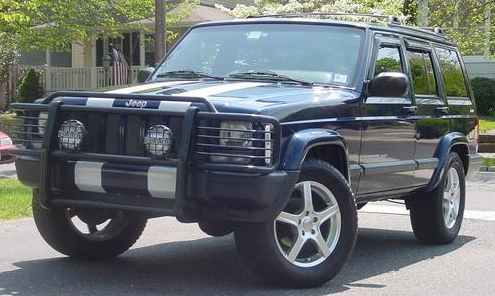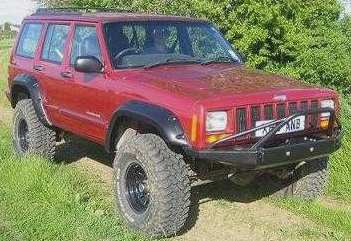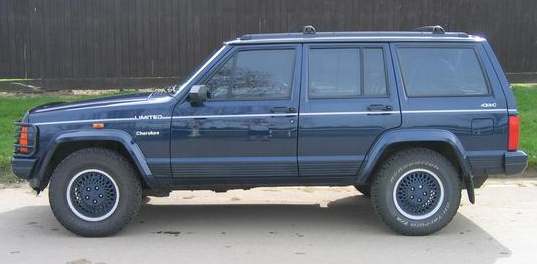|
THE JEEP CHEROKEE
|
|
|
This classic Blue Jeep Cherokee is in good condition with a private plate: "HAZ 2481". She's done 105,000 miles and has been regularly serviced.
This is the six cylinder,4.0 liter petrol fuel injected high output SE model featuring automatic transmission. She has full beige leather trim, electric seats and electric windows. She also has air conditioning, stereo, cruise control, earth sensing compass, specialist fitted car alarm, and a towbar.
A recent serviced included new ancillary drive belt, engine oil flush, new filter and fully synthetic oil change. Slick 50 (the large size) was also added for extra protection. The car has just had four new oversize 'All Terrain' tyres fitted and balanced. A performance 4x4 drives superb.
Priced realistically @ £5,995 ovno including cherished plate Location: Eastbourne in Sussex
HISTORY OF THE JEEP
The Bantam Car Company won the opening round of the contest to satisfy the US army's 1940 specification for a light four wheel drive but Willys Overland won the battle and, some would say, the war. To ensure supply in war-time the Army decided on a second supplier - Ford. Between 1941 and 1945 Willys and Ford built about 700,000 of the vehicle.
Easiest ways to tell a Ford GPW from a Willys MB:
The Willys chassis front Cross-member is tubular, whereas the Ford cross-member is an inverted U section. Other ways include looking at the tops of all the nuts and bolts, Fords should all be script F marked, though this is not reliable as some restorers replace all the nuts and bolts with new ones. Most of the panels on a Ford Jeep will be stamped with a script F somewhere or another. For example in the middle of the seat frames (back panel), top of the mud guards, on the bonnet hinge, on the rear foot rests, even on the reflectors for some models. I think that the Ford Motor Co. made sure that their stamp was on every sub-assembly of their vehicles.
Willys Overland Jeep MB : Specifications
soft-top, 2+2 seats, what doors? loa: 132", width: 62", height: 52" (steering wheel) - 72" (soft top), weight: 2400 (unladen) GVM: 3200lbs nominally 2199cc petrol 4-cyls, 2 valves/cyl, side-valve bore: 79.4mm, stroke: 111mm, c.r.: 6.48:1 transmission: 3-speed, 2-speed transfer case, part-time 4WD suspension: beam-leaf/beam-leaf, brakes: drum/drum tyres: 6.00x16 Go to the Bantam, Rifkind report
What a beauty. This classic wagon is still going strong and about to be used to carry out some interesting scientific experiments in connection with plastic ocean waste.
THE JEEP IN CIVILIAN CLOTHING
When the liberating heroes came home in 1945 they needed an all-terrain vehicle like the original Jeep CJ for adventure and family. Willys-Overland answered the call with the first all-steel station wagon, equipped with a six cylinder petrol engine and what was to become Jeep's legendary four wheel drive.
Introduced a year after the first civilian Jeep vehicle, the Jeep CJ-2A, the Willys-Overland all-steel station wagon was an auto industry first. The new wagon provided all the capability and ruggedness of the original four-wheel-drive Jeep CJ with the practicality and increased passenger and cargo space of a station wagon.
The new 'Jeep' station wagon had pressed steel framing and three-tone paintwork which simulated the wood look. It used Jeep running gear and MB-style front sheet metal and was designed to compete against the "real" wood wagons still being manufactured by Detroit's Big Three.
THE
FIFTIES
THE SEVENTIES
THE EIGHTIES
The
new version of the Cherokee was introduced in 1984. It was available in a two
or four door wagon body style. Unit-Body construction, and a much-improved
suspension lead the list of features. The four wheel leaf springs were
replaced by front coil springs and rear leaf springs. The new Cherokee was
much lighter and fuel efficient than the old model. Very few parts were
carried over from the old models. Four Wheel Drive was optional on all models,
and All Wheel Drive was available on some models. Automatic hubs were standard
on all 4x4 models. The Cherokee was offered in two-door and four-door
configurations.
1994 Jeep Cherokee bigfoot
The base powertrain was a four speed manual transmission with the AMC 2.5l (151 cid) four cylinder engine. The 2.5l four gained fuel injection, and an optional five speed transmission for the 1986 model year. A three or four speed automatic transmission was also available with the four cylinder. A 2.8l six cylinder was also available with a five speed manual or four speed automatic transmission. The original six cylinder was not an AMC engine; it was made by General Motors. The V-6 was the same engine that was used in many Chevy and GMC Trucks, and Pontiac and Chevy Sedans. This V-6 was sold by AMC with a 2bbl carburator.
A four cylinder Diesel was also available with either the five speed manual or four speed automatic. The Diesel engine was the Renault 2.0l Turbo-Diesel. Most of the Diesel Cherokees were sold in Canada and Europe. In 1986, a pickup truck body was added, the Commanche. It had bed rails welded onto the back of the cab in lieu of a true frame. The Commanche is probably the highest production Unit-Body pickup truck ever produced.
These configurations were available through the 1986 model year, in four body trims: base, Chief, Laredo, and Wagoneer. In 1987, the whole line was revamped, with a new six cylinder engine, and the discontinuance of the Diesel model in the United States. The new six cylinder was a 4.0l (242 cid) inline, Throttle-Body Injected engine. This engine, aside from being much more powerful and reliable than the V-6, was the last true AMC engine, based on the 2.5l four.
The Commanche was available in four trims, base, Sport, Chief, and Laredo. Sales of the Cherokee and Commanche took off in 1987; unfortunately, AMC had already agreed to the merger with Chrysler. Chrysler made few changes to the Cherokee after the takeover. Most of the changes were in the wiring for the Stereo, A/C, etc. etc. Chrysler also changed the instrument panel for the 1990 model year, but changed it back to the old AMC panel in 1993. Both engines gained Multi-Port Fuel Injection for the 1991 model year. The 2.5l went to 125 bhp, and the 4.0l went to 190 bhp.
The 1997 model year brought about the most radical changes in the Cherokee's design since it's introduction 13 years prior. The body panels were redesigned for improved aerodynamics, and the interior was changed to a more Chrysler-esque design. The interior was the most radical change, where the Cherokee's boxy, Renault-Insipried design became very rounded and modern. Chrysler plans to continue producing the Cherokee base Unit-Body unchanged through the 2000 model year. The 2 Millionth Cherokee rolled off the line at the Toledo, Ohio, plant in July 1996 with President Clinton behind the wheel.
Today, the latest version of the Cherokee combines over 50 years of engineering and technological excellence with the classic styling and practicality of a Jeep vehicle. Be sure to check out all the refinements to this American icon: an all-new interior, dual air-bags** and UniFrame construction.
JEEP LINKS:
http://www.jeep.co.uk/ http://en.wikipedia.org/wiki/Jeep
|
|
|
This website is Copyright © 1999 & 2014 Max Energy Limited, an environmental educational charity working hard for world peace. The names Solar Navigator™,Blueplanet Ecostar BE3™ and Utopia Tristar™ are trademarks. All other trademarks are hereby acknowledged.
|



